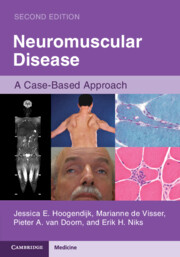Book contents
- Neuromuscular Disease: A Case-Based Approach
- Neuromuscular Disease
- Copyright page
- Contents
- Contributors
- Foreword
- Preface to 2nd Edition
- Part I Evaluation and Treatment of Patients with a Neuromuscular Disorder
- Part II Neuromuscular Cases
- Disorders of the Anterior Horn Cell
- Peripheral Neuropathies
- Case 9 Guillain–Barré Syndrome (GBS) and Miller–Fisher Syndrome (MFS)
- Case 10 Chronic Inflammatory Demyelinating Polyneuropathy (CIDP)
- Case 11 IgM Anti-MAG Polyneuropathy
- Case 12 Polyneuropathy, Organomegaly, Endocrine Manifestations, Monoclonal Protein, and Skin Changes (POEMS) Syndrome
- Case 13 Vasculitic Neuropathy
- Case 14 Small-Fibre Neuropathy (SFN)
- Case 15 Sensory Neuronopathy (SNN, Ganglionopathy)
- Case 16 Wartenberg Migrant Sensory Neuropathy
- Case 17 Multifocal Motor Neuropathy (MMN)
- Case 18 Peripheral Nerve Hyperexcitability Syndromes: Morvan Syndrome
- Case 19 Idiopathic Brachial Plexus Neuropathy, Neuralgic Amyotrophy (NA)
- Case 20 Diabetic Neuropathy
- Case 21 Alcoholic Polyneuropathy
- Case 22 Chronic Idiopathic Axonal Polyneuropathy (CIAP)
- Case 23 Critical Illness Polyneuropathy and Myopathy (CIPM)
- Case 24 Drug-Induced Polyneuropathies: Amiodarone Polyneuropathy
- Case 25 Lyme Radiculopathy
- Case 26 Leprosy
- Case 27 Charcot–Marie–Tooth Disease (CMT) Type 1A/Hereditary Neuropathy with Liability for Pressure Palsies (HNPP)
- Case 28 Charcot–Marie–Tooth Disease (CMT) Type 2 A and Type 2B
- Case 29 Hereditary Sensory and Autonomic Neuropathy (HSAN) Type 4
- Case 30 Hereditary Transthyretin (TTR) Amyloidosis
- Disorders of the Neuromuscular Junction
- Myopathies
- Video legends
- Index
- References
Case 28 - Charcot–Marie–Tooth Disease (CMT) Type 2 A and Type 2B
from Peripheral Neuropathies
Published online by Cambridge University Press: 29 November 2024
- Neuromuscular Disease: A Case-Based Approach
- Neuromuscular Disease
- Copyright page
- Contents
- Contributors
- Foreword
- Preface to 2nd Edition
- Part I Evaluation and Treatment of Patients with a Neuromuscular Disorder
- Part II Neuromuscular Cases
- Disorders of the Anterior Horn Cell
- Peripheral Neuropathies
- Case 9 Guillain–Barré Syndrome (GBS) and Miller–Fisher Syndrome (MFS)
- Case 10 Chronic Inflammatory Demyelinating Polyneuropathy (CIDP)
- Case 11 IgM Anti-MAG Polyneuropathy
- Case 12 Polyneuropathy, Organomegaly, Endocrine Manifestations, Monoclonal Protein, and Skin Changes (POEMS) Syndrome
- Case 13 Vasculitic Neuropathy
- Case 14 Small-Fibre Neuropathy (SFN)
- Case 15 Sensory Neuronopathy (SNN, Ganglionopathy)
- Case 16 Wartenberg Migrant Sensory Neuropathy
- Case 17 Multifocal Motor Neuropathy (MMN)
- Case 18 Peripheral Nerve Hyperexcitability Syndromes: Morvan Syndrome
- Case 19 Idiopathic Brachial Plexus Neuropathy, Neuralgic Amyotrophy (NA)
- Case 20 Diabetic Neuropathy
- Case 21 Alcoholic Polyneuropathy
- Case 22 Chronic Idiopathic Axonal Polyneuropathy (CIAP)
- Case 23 Critical Illness Polyneuropathy and Myopathy (CIPM)
- Case 24 Drug-Induced Polyneuropathies: Amiodarone Polyneuropathy
- Case 25 Lyme Radiculopathy
- Case 26 Leprosy
- Case 27 Charcot–Marie–Tooth Disease (CMT) Type 1A/Hereditary Neuropathy with Liability for Pressure Palsies (HNPP)
- Case 28 Charcot–Marie–Tooth Disease (CMT) Type 2 A and Type 2B
- Case 29 Hereditary Sensory and Autonomic Neuropathy (HSAN) Type 4
- Case 30 Hereditary Transthyretin (TTR) Amyloidosis
- Disorders of the Neuromuscular Junction
- Myopathies
- Video legends
- Index
- References
Summary
A 40-year-old man was referred because he wished to be informed about the genetic nature of his disorder. He was diagnosed with Charcot–Marie–Tooth (CMT) disease. At 14 months of age, he started walking, but awkwardly due to a bilateral drop foot for which braces were prescribed. On first examination at age 2 years and 8 months, there was marked atrophy, hypotonia, and areflexia of the lower legs, and slight wasting of the thenar and hypothenar. At that time, nerve conduction studies showed normal motor conduction velocities of arm nerves. No motor unit action potentials could be recorded in the lower leg muscles on concentric needle examination.
Keywords
- Type
- Chapter
- Information
- Neuromuscular DiseaseA Case-Based Approach, pp. 149 - 150Publisher: Cambridge University PressPrint publication year: 2024

